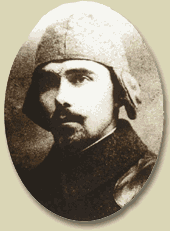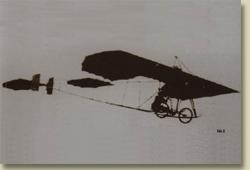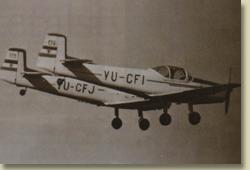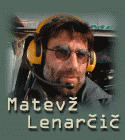

| Slovenia was, and still is, a small country. Smaller nations were always falling behind larger ones regarding technical achievements and, in many instances, we were no exception. In Slovenia, however, one such bright exception was aviation.
Beginning of the 20th century
 |
| Edvard Rusjan | Prior to the beginning of the 20th century, some individuals attempting to fly in Slovenia covered short distances only by good fortune. In 1909, aviation and the Rusjan brothers from Gorica became known to each other. The two brothers, Edvard and Joseph, visited an aviation display in Brescia, Italy, where they became fascinated by the idea of flying with powered airplanes. Only two months after the display in Brescia, the industrious brothers had constructed and flown their own airplane. On 25th November 1909, Edvard Rusjan made a few of the first controlled forays into the air. A few days later, they carried out some minor modifications on their airplane, named after Edvard EDA 1, and managed to stay in the air for more than one minute in what is commonly considered to be the start of powered flight in Southeastern Europe. A few more days later, they abandoned flight testing of their first airplane; it probably had something to do with a collision with a horse carriage on the take off runway. The Rusjan brothers proceeded with flight testing of their own airplanes until the beginning of the year 1911, when Edvard Rusjan died in a plane crash in Belgrade.
Up to the First World War, some Slovenian airplane constructors were active, but they were especially productive abroad. Probably the most important of them was Stanko Bloudek, who started his construction career during his studies in Prague. He designed and produced different small non-steerable gliders. He and his friends used them to glide from the banks of the river Vltava. The river was a precautionary measure in cases where something went wrong with the designs. Later on, he and his two companions constructed the first successful airplane in Czechia. Because of the nearby Isonzo front during the First World War, there were few aviation units active on the airfields of Divaca and Ajdovscina in Southern Slovenia. Those aviation units became important for Slovenia and her aviation history at the end of the war when the Austro-Hungarian monarchy fell apart. All their war material was confiscated and it stayed in Slovenia. Slovenia formed air combat units out of the remaining airplanes, and with personnel in Ljubljana and Maribor. Right after the end of the war, a dispute arose between Slovenia and Austria regarding the border line and the newly formed, and so-called, Slovenian air force played a vital role in the defence of Slovenian northern territories.
At the same time, Slovenia amalgamated its territory with the other southern Slavic nations and the Serbian, Croatian and Slovenian kingdom was born. In this new kingdom, aviation swiftly became centred in Serbia. Both Slovenian air combat units were disbanded and the personnel and material were transferred to Novi Sad.
Between the First and Second World Wars
 |
| Aircraft EDA 5 | During the two decades between the First and Second World Wars, aero club organisations in Ljubljana and Maribor district were formed. Under their jurisdictions were 14 active aero clubs with more than 1,000 members (facts from year 1928). Club members found different ways of getting the equipment they needed. Powered airplanes were, in many cases old, demobilised training aircraft. A few private single- and double-seater airplanes were home-produced from plans drawn-up by constructors Anton Kuhelj and Stanko Bloudek, who returned after the war to Slovenia. Homebuilders always used their skills and knowledge to improve their airplanes during the construction phase. At first, all the gliders were produced from foreign plans by different groups of enthusiasts. Later on, the gliders were first constructed abroad and then even re-produced in small numbers at home in Slovenia. An important influence on the development and popularisation of gliding in Slovenia and Yugoslavia came from gliding centres organised according to German and Polish principles in Bloke, Kompole and on Slivnica above Cerknica lake.
During the first few days of the Second World War, Slovenian civil aviation lost almost all of its existing aircraft. Some of them were destroyed by their owners. Others were destroyed by different paramilitary organisations. During the war, there were only a few occasionally active German Luftwaffe units stationed on the territory of Slovenia.
After the Second World War
 |
| Aircraft KB-11 | Right after the termination of hostilities, Slovenian aviation started to develop rapidly. Under the supervision of the newly formed sporting aviation organisation, later called the Association of Aviation Organisations of Slovenia, which was heavily sponsored by the Yugoslav military air force, formal aero clubs became active again. Their activities were at first carried out on board confiscated airplanes and former Russian military training aircraft, but soon the Construction Bureau of the above mentioned AAOS aviation factory started to design and produce new successful types of airplanes. The Construction Bureau (KB) produced some beautiful light wooden airplanes in a limited series. The KB-11, resembling in outline a Beechcraft Bonanza, was the most complicated and biggest of them all.
When the aviation industry substituted metal for wood as the prime construction material the costs of production rose. That had a drastic affect on the boutique aviation industry in Slovenia and both of the workshops closed.
Around 1980, a well-known producer of sporting equipment, ELAN from Begunje, started to think about licensed glider production. Along with their partner, Glaser-Dirks from Germany, they soon started to produce single-seaters of the DG-100 and DG-101 types. Later, ELAN became involved in next generation designs of single-seater DG-300 and double-seater DG-500 aircraft. Both types are still in production.
With the start of domestic glider production, the aero clubs were once again able to get their hands on new types of gliders and, after a long pause, Slovenian glider pilots successfully returned to gliding in world championships. Powered airplanes were, with the help of sponsors, in many cases bought in United States. Other powered airplanes were given to aero clubs by the Yugoslav Air Force.
When Slovenia proclaimed independence in 1991, there were 14 active aero clubs with 1,500 members in the country, all of them affiliated to the Aeronautical Association of Slovenia.
After 1991, when private initiative in Slovenia became a factor once again, some specialised private companies started to produce airplanes and aviation equipment. Aircraft, airplane instruments and other aviation equipment, made in Slovenia, are no longer exotic or rare specimens on the international market. |
|
 |



|

